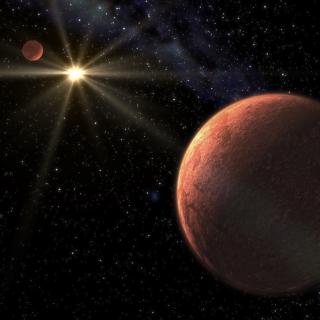Bibcode
Nagel, E.; Czesla, S.; Schmitt, J. H. M. M.; Dreizler, S.; Anglada-Escudé, G.; Rodríguez, E.; Ribas, I.; Reiners, A.; Quirrenbach, A.; Amado, P. J.; Caballero, J. A.; Aceituno, J.; Béjar, V. J. S.; Cortés-Contreras, M.; González-Cuesta, L.; Guenther, E. W.; Henning, T.; Jeffers, S. V.; Kaminski, A.; Kürster, M.; Lafarga, M.; López-González, M. J.; Montes, D.; Morales, J. C.; Passegger, V. M.; Rodríguez-López, C.; Schweitzer, A.; Zechmeister, M.
Bibliographical reference
Astronomy and Astrophysics, Volume 622, id.A153, 13 pp.
Advertised on:
2
2019
Journal
Citations
24
Refereed citations
22
Description
We report the detection of a Neptune-mass exoplanet around the M4.0
dwarf GJ 4276 (G 232-070) based on radial velocity (RV) observations
obtained with the CARMENES spectrograph. The RV variations of GJ 4276
are best explained by the presence of a planetary companion that has a
minimum mass of mb sin i ≈ 16 M⊕ on a
Pb = 13.35 day orbit. The analysis of the activity indicators
and spectral diagnostics exclude stellar induced RV perturbations and
prove the planetary interpretation of the RV signal. We show that a
circular single-planet solution can be excluded by means of a likelihood
ratio test. Instead, we find that the RV variations can be explained
either by an eccentric orbit or interpreted as a pair of planets on
circular orbits near a period ratio of 2:1. Although the eccentric
single-planet solution is slightly preferred, our statistical analysis
indicates that none of these two scenarios can be rejected with high
confidence using the RV time series obtained so far. Based on the
eccentric interpretation, we find that GJ 4276 b is the most eccentric
(eb = 0.37) exoplanet around an M dwarf with such a short
orbital period known today.
Photometric measurements and Table C.1 are available at the CDS via
anonymous ftp to http://cdsarc.u-strasbg.fr
(ftp://130.79.128.5) or via http://cdsarc.u-strasbg.fr/viz-bin/qcat?J/A+A/622/A153
Related projects

Very Low Mass Stars, Brown Dwarfs and Planets
Our goal is to study the processes that lead to the formation of low mass stars, brown dwarfs and planets and to characterize the physical properties of these objects in various evolutionary stages. Low mass stars and brown dwarfs are likely the most numerous type of objects in our Galaxy but due to their low intrinsic luminosity they are not so
Rafael
Rebolo López

Exoplanets and Astrobiology
The search for life in the universe has been driven by recent discoveries of planets around other stars (known as exoplanets), becoming one of the most active fields in modern astrophysics. The growing number of new exoplanets discovered in recent years and the recent advance on the study of their atmospheres are not only providing new valuable
Enric
Pallé Bago